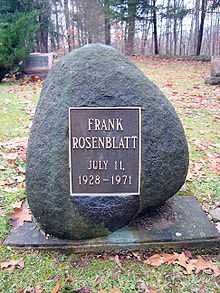Frank Rosenblatt

Frank Rosenblatt (11 July 1928 – 11 July 1971) was a New York City born psychologist who completed the Perceptron, or MARK 1, computer at Cornell University in 1960. This was the first computer that could learn new skills by trial and error, using a type of neural network that simulates human thought processes.
Rosenblatt’s perceptrons were initially simulated on an IBM 704 computer at Cornell Aeronautical Laboratory in 1957. By the study of neural networks such as the Perceptron, Rosenblatt hoped that "the fundamental laws of organization which are common to all information handling systems, machines and men included, may eventually be understood."
Background
A 1946 graduate of the Bronx High School of Science, Rosenblatt was a colorful character at Cornell in the early 1960s. A handsome bachelor, he drove a classic MGA sports car and was often seen with his cat named Tobermory. He enjoyed mixing with undergraduates, and for several years taught an interdisciplinary undergraduate honors course entitled "Theory of Brain Mechanisms" that drew students equally from Cornell's Engineering and Liberal Arts colleges.
This course was a melange of ideas drawn from a huge variety of sources: results from experimental brain surgery on epileptic patients while conscious, experiments on measuring the activity of individual neurons in the visual cortex of cats, studies of loss of particular kinds of mental function as a result of trauma to specific areas of the brain, and various analog and digital electronic circuits that modeled various details of neuronal behavior (i.e. the perceptron itself, as a machine).
Neurodynamics
There were also some breathtaking speculations, based on what was known about brain behavior at this time (well before the CAT or PET scan was available), including one calculation that, based on the number of neuronal connections in a human brain, the human cortex had enough storage space to hold a complete "photographic" record of its perceptual inputs, stored at the 16 frames-per-second rate of flicker fusion, for about two hundred years.
In 1962 Rosenblatt published much of the content of this honors course in the book "Principles of neurodynamics: Perceptrons and the theory of brain mechanisms" (Spartan Books, 1962) which he used thereafter as a textbook for the course.
Research on similar devices was also being done in other places such as SRI, and many researchers had big expectations on what they could do. The initial excitement became somewhat reduced, though, when in 1969 Marvin Minsky and Seymour Papert published the book Perceptrons with mathematical proofs that elucidated some of the characteristics of the three-layer feed-forward perceptrons. For one side, they demonstrated some of the advantages of using them on certain cases. But they also presented some limitations. The most important one was the impossibility of implementing general functions using only "local" neurons, that don't have all inputs available. This was taken by many people as one of the most important characteristics of perceptrons.
On His Death
Rosenblatt died in a boating incident in 1971. He is buried at Quick Cemetery in Brooktondale, New York. After research on neural networks returned to the mainstream in the 1980s, new researchers started to study his work again. This new wave of study on neural networks is interpreted by some researchers as being a contradiction of hypotheses presented in the book Perceptrons, and a confirmation of Rosenblatt's expectations, but the extent of this is questioned by some. [1]
In 2004 the IEEE established the Frank Rosenblatt Award, for "outstanding contributions to the advancement of the design, practice, techniques or theory in biologically and linguistically motivated computational paradigms including but not limited to neural networks, connectionist systems, evolutionary computation, fuzzy systems, and hybrid intelligent systems in which these paradigms are contained."[2]
References
See also
- Artificial neural networks
- History of artificial intelligence
- AI Winter
- Perceptrons